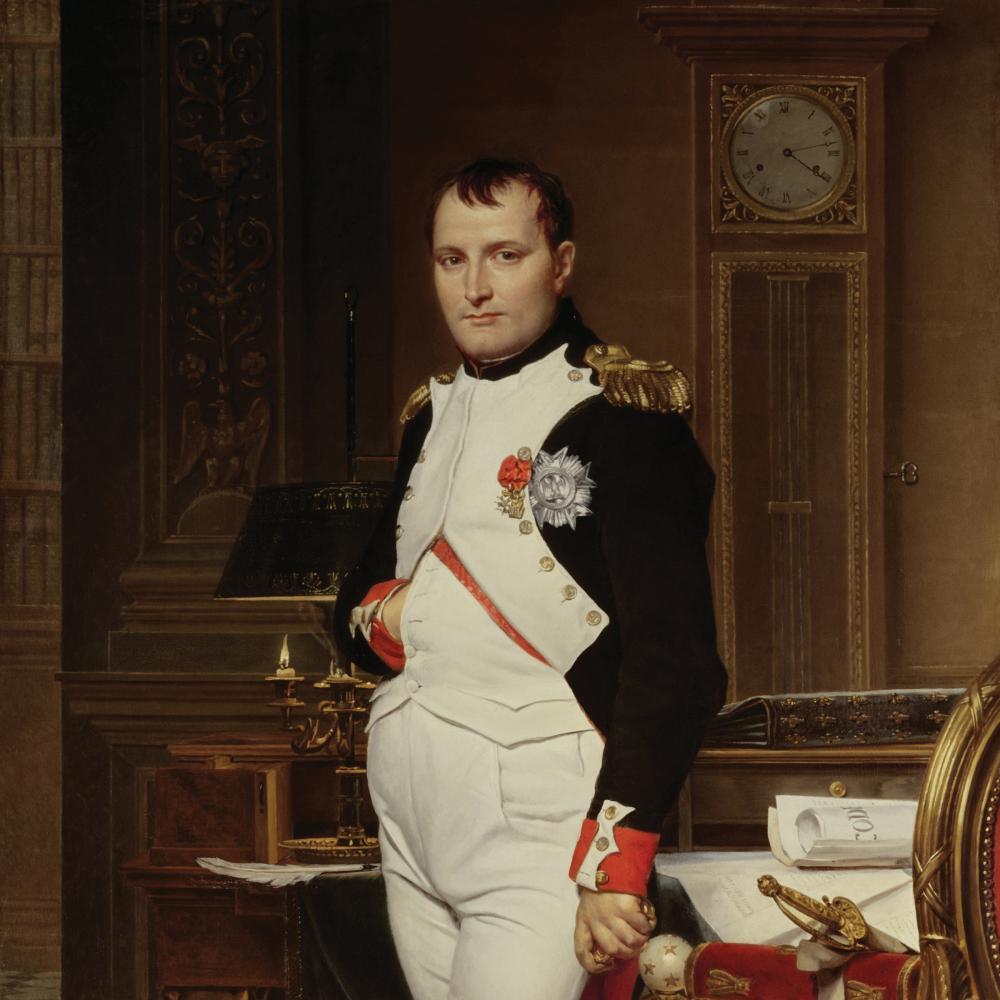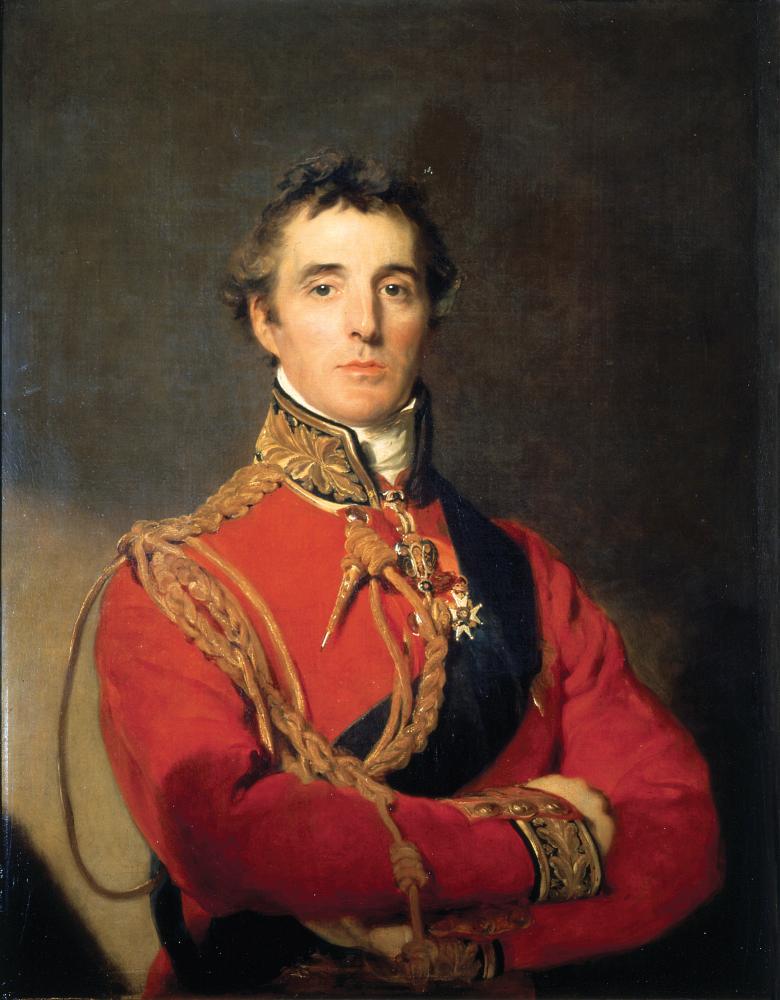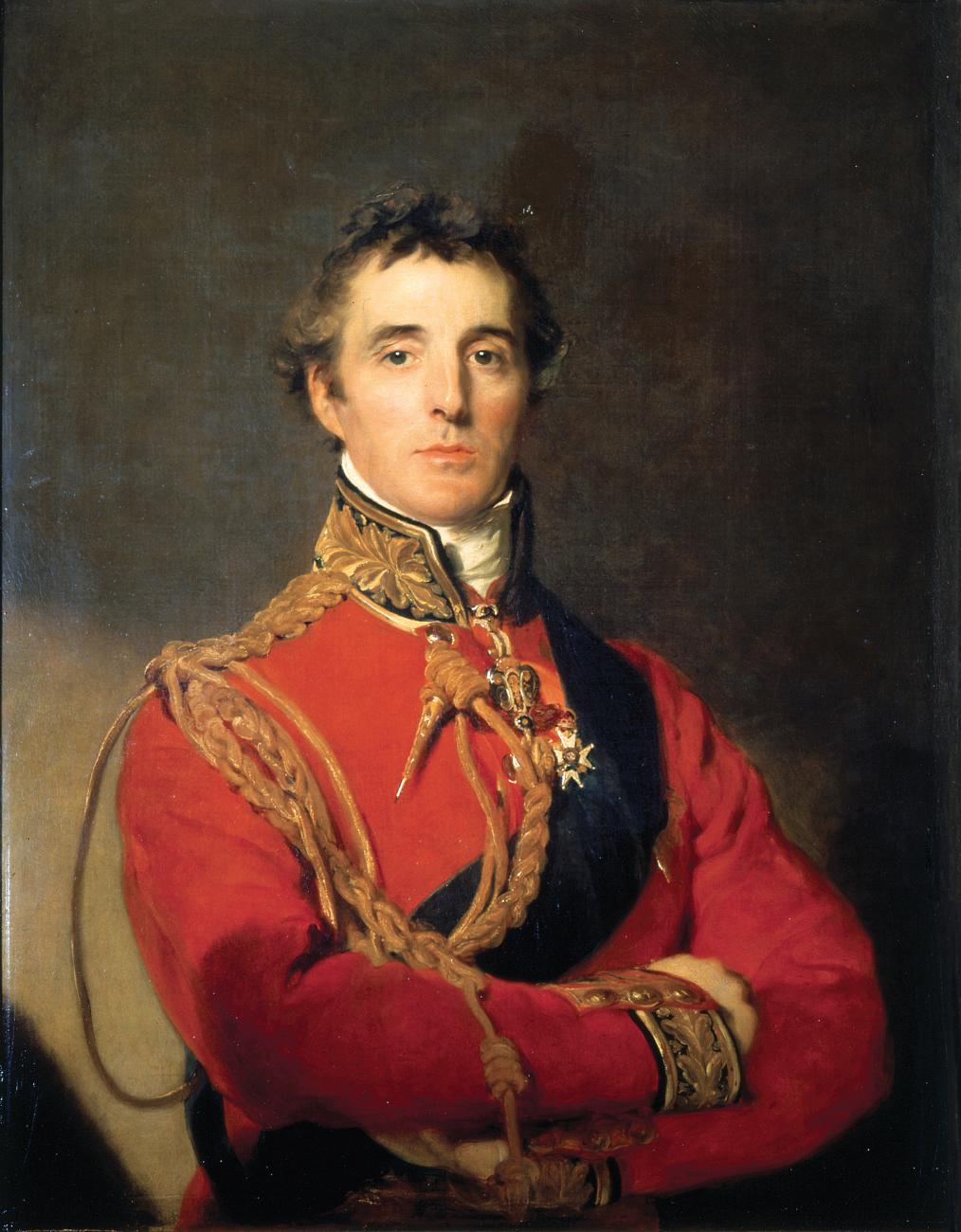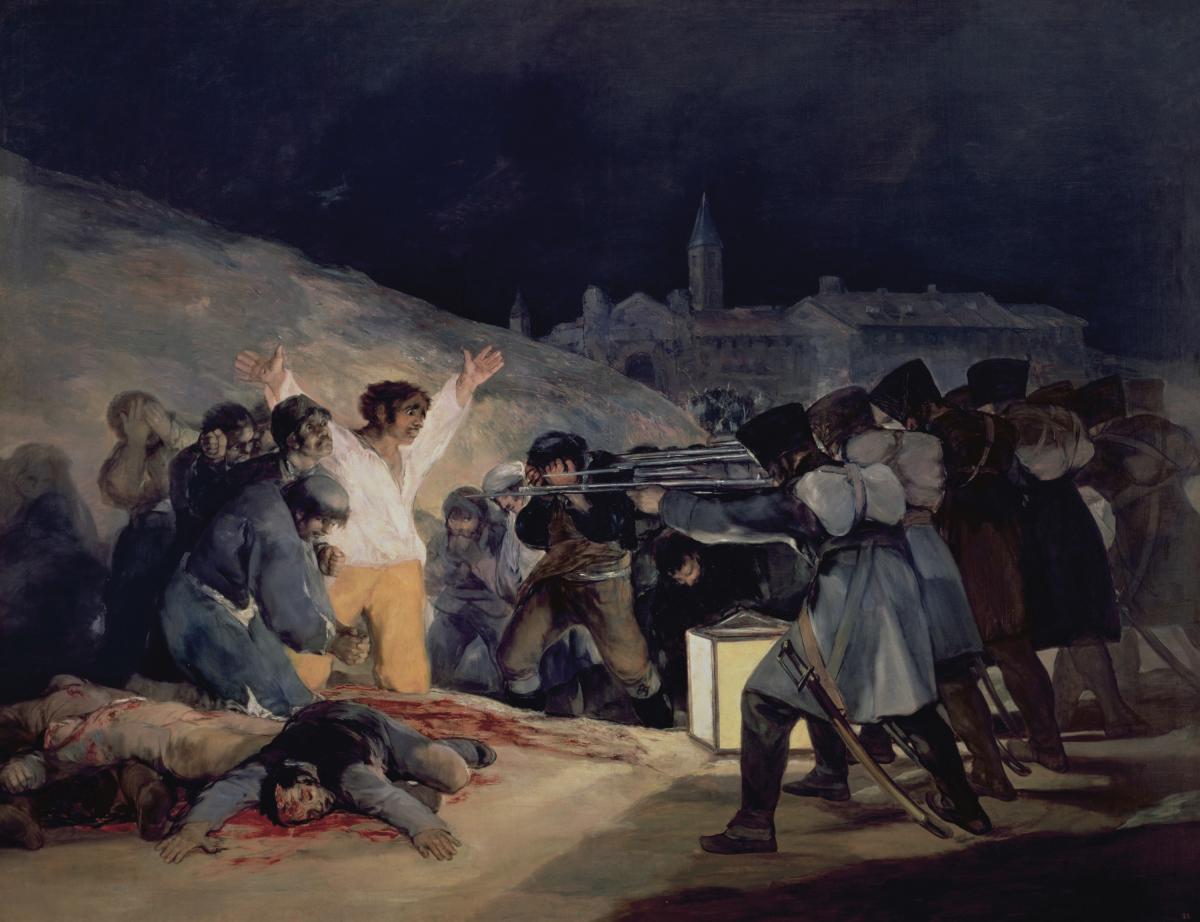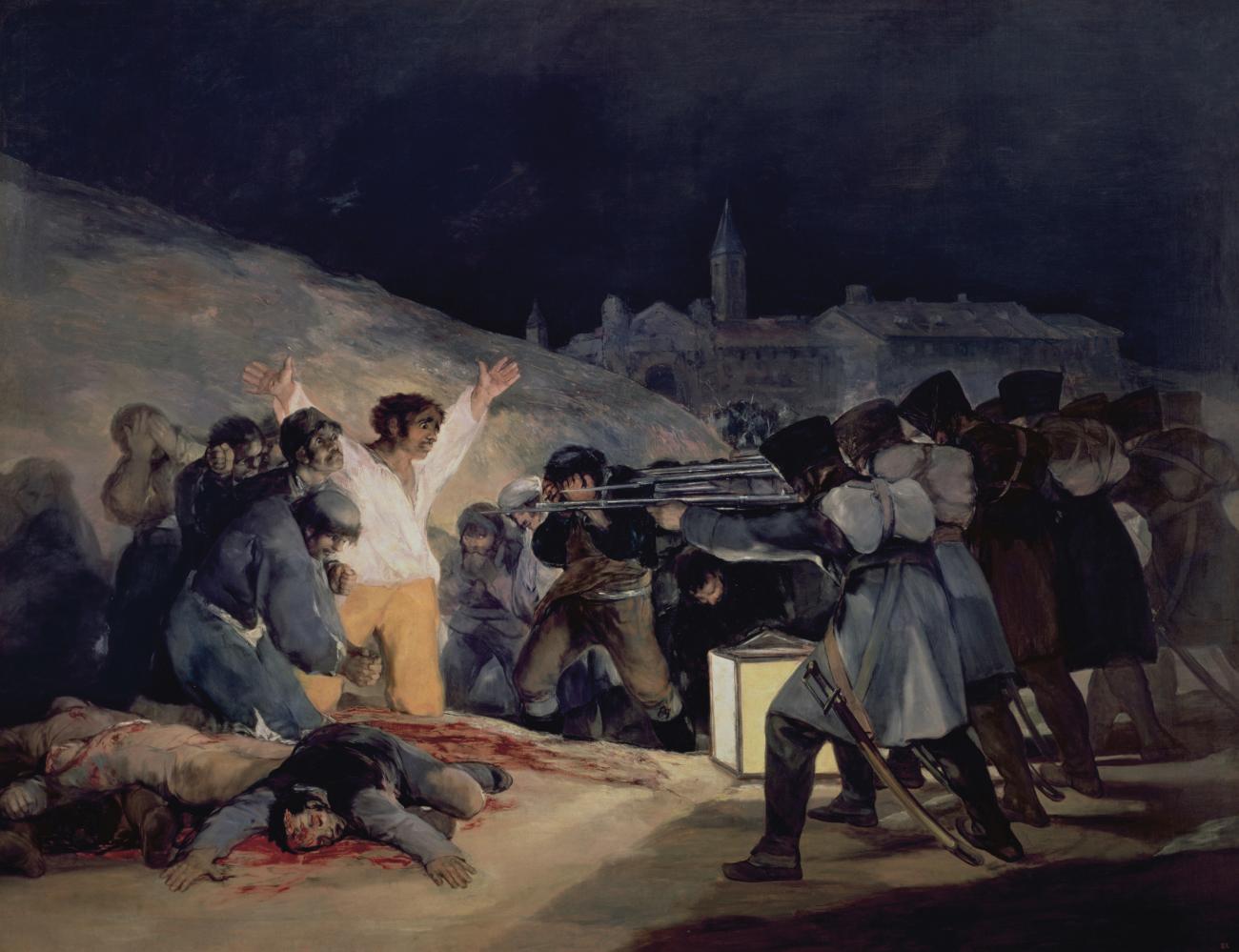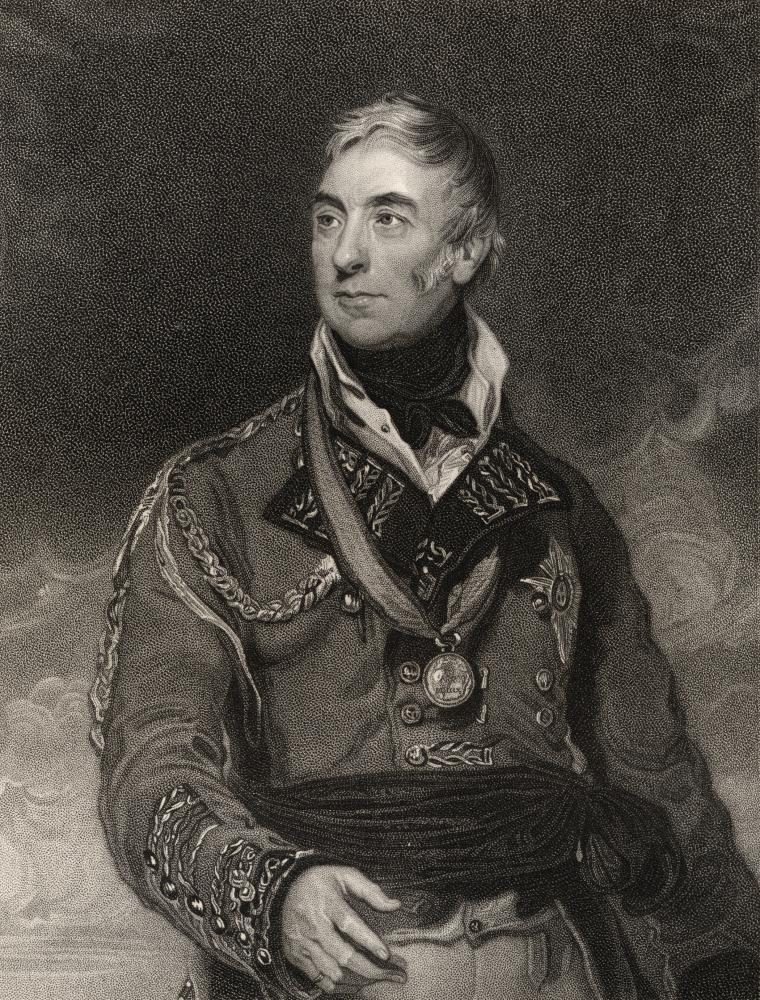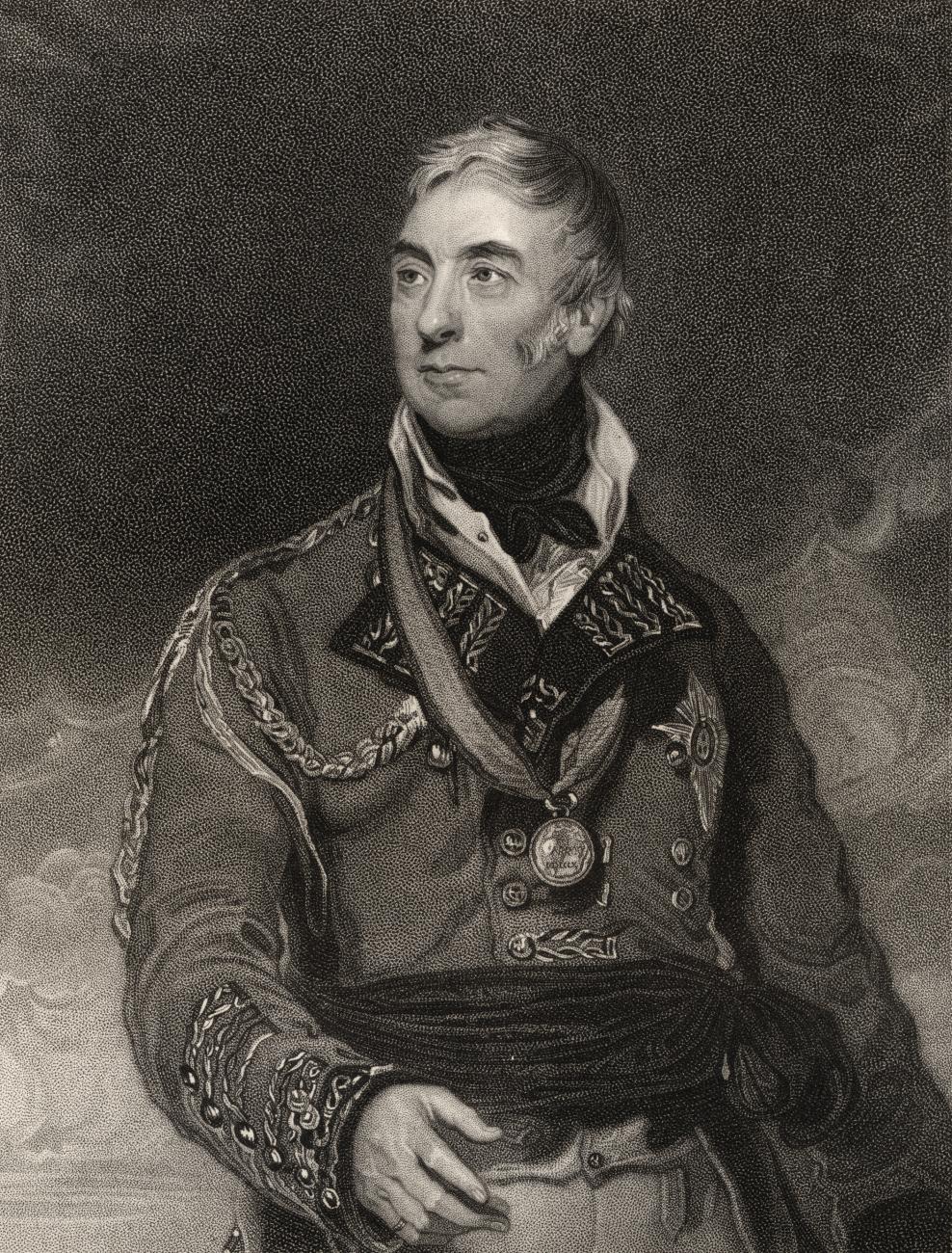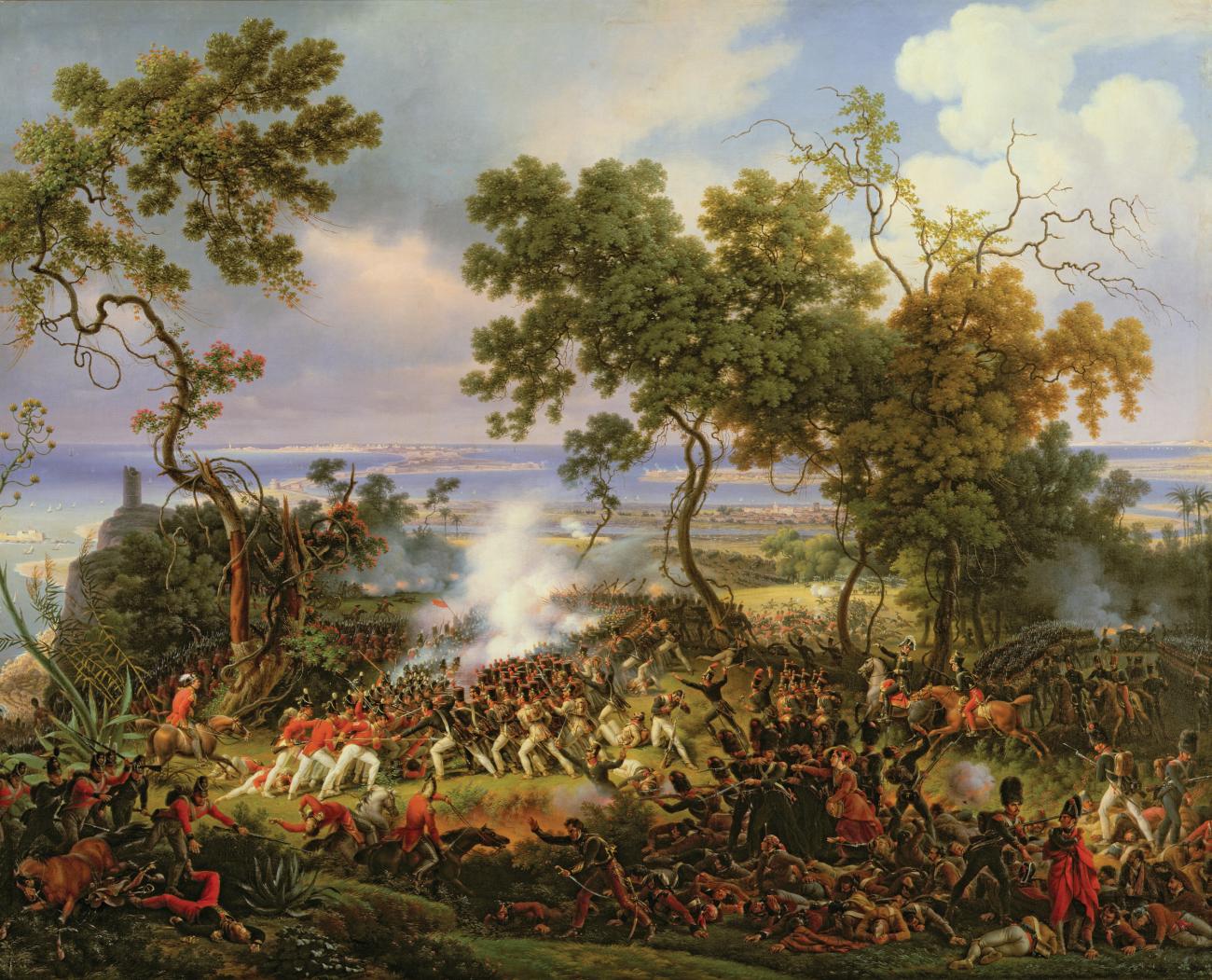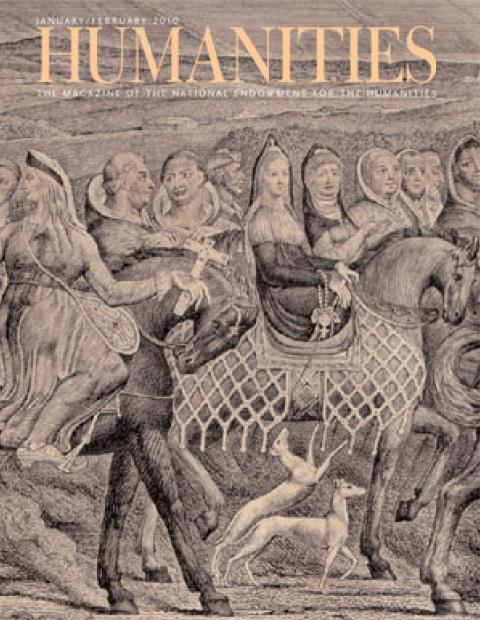When Marshal Claude Victor-Perrin arrived at the gates of the island fortress of Cádiz, in Andalusia, he was confident the poorly defended town would immediately surrender. He and his troops had marched eighty-three miles in four days to take control of the last outpost of Spanish rebellion against Emperor Napoleon Bonaparte. Madrid was already in French hands, along with the rest of northern Spain. Days earlier on February 1, 1810, Napoleon’s brother, King Joseph, had ridden triumphantly through the gates of Seville. Spain seemed all but conquered.
But Cádiz’s governor refused to surrender. Over the centuries, the town’s thick stone walls had repelled the Moors, Barbary pirates, and the British. That morning, its walls harbored something else: twelve thousand men representing the last remnants of the Spanish army. Realizing Seville was lost, the Duke of Albuquerque had marched his ten thousand men to Cádiz, picking up another two thousand men from towns along the way. He arrived two days before Victor. If the French wanted the town, they would have to lay siege to it.
When the dust settled on the Napoleonic Wars, Cádiz held the distinction of being the only city in continental Europe to survive a siege by Napoleon. It wasn’t for lack of effort by the French. For thirty-one months—from February 5, 1810, to August 25, 1812—the French army cut Cádiz off from the rest of Spain and subjected the town to constant bombardment. And for the past two hundred years, historians and armchair generals have debated what would have happened if the French had captured it. Napoleon might have wondered the same. The “Spanish ulcer,” as he would call the Peninsular War, helped to sow his defeat.
“I must make all the peoples of Europe one people and Paris the capital of the world,” declared Napoleon. By 1807 his empire spanned from the Atlantic coast of France to the frontier of Russia. But there was one jewel missing from his crown. Britain had evaded every attempt at conquest, a credit to its naval prowess. If he couldn’t beat Britain on the high seas, Napoleon decided he would cripple its economy. “The English are a nation of merchants,” Austrian Emperor Francis II had complained to Napoleon in 1805. “To secure for themselves the commerce of the world, they are willing to set the continent in flames.”
Napoleon’s weapon of choice was his Continental system, an economic blockade that sought to prevent Britain from trading at any port in Europe. Although Portugal pledged its allegiance, it frequently let British ships dock at its ports. Napoleon decided this insolence must be stopped. Spain had proven equally unreliable, having flirted with aligning with Prussia against him. Napoleon also blamed Spain, rather than British naval superiority, for the debacle at Trafalgar that in 1805 had destroyed the French and Spanish navies. He also thought Spain would be an easy conquest. King Carlos IV was erratic and unstable, while his heir, Fernando VII, was as dumb as he was vain. The power vacuum was filled by Manuel de Godoy, a private soldier who became a crown favorite, it was rumored, by patronizing Queen Maria Luisa’s bed. Godoy, though also suspected of duplicity, at least was in Napoleon’s pay.
In November 1807, Napoleon sent twenty-eight thousand men over the Pyrenees, through Spain, and into Portugal. The French army’s passage through Spain was arranged by Godoy. The Portuguese royal family fled to Brazil. Next Napoleon turned on Spain, seizing fortresses and citadels and flooding the country with one hundred and-twenty thousand French soldiers. In March 1808, King Carlos IV abdicated in favor of his son, then withdrew it, much to Fernando’s displeasure. Rather than prop up the Bourbons, for whom he had nothing but contempt, Napoleon persuaded his brother Joseph, King of Naples, to relinquish that crown in favor of Spain’s. The Bourbons and Godoy were sent into exile, while the troublesome Fernando was locked in the gilded prison of Château de Valençay.
And still there were problems. “Napoleon’s policy in Spain proved one of his greatest blunders,” writes historian David Chandler. “Nothing turned out as intended. From the beginning, he entirely misjudged the problem with which he had to deal. He never appreciated how independent the Spanish people were of their government; he misjudged the extent of their pride, of the tenacity of their religious faith, of their loyalty to Ferdinand. He anticipated that they would accept the change of regime without demur; instead he soon found himself with a war of truly national proportions on his hands.”
In May, Spain rebelled. The bloody street combat and summary executions that took place in Madrid would be immortalized by Goya in his paintings Dos de Mayo and Tres de Mayo. Pro-French governors were assassinated in Badajoz, Cartagena, and Cádiz. Armies rose up in every province. The French and Spanish traded atrocities. In the name of retaliation and example-setting, towns were leveled, civilians slaughtered, and soldiers executed. The French army crushed the poorly organized Spanish forces until a mid July encounter at the town of Bailén: France’s poor leadership and inexperienced troops, along with mountainous terrain, tipped the battle to Spain. Nineteen thousand French soldiers surrendered, marking the first time since 1801 that a large French force had capitulated. Napoleon’s army was not invincible—and now all of Europe knew it. Of the defeat, Napoleon later remarked, with characteristic equanimity, “There has never been anything so stupid, so foolish or so cowardly since the world began.”
Spain’s resistance caught the attention of Britain. At war with France on and off since 1793, it was continually on the lookout for French vulnerabilities. The long struggle, however, had taken its toll on the British people and the nation’s coffers. As William Wordsworth wrote of Britain’s predicament:
Another year!—Another deadly blow!
Another mighty Empire overthrown!
And We are left, or shall be left, alone;
The last that dare to struggle with the Foe.
But helping Spain would require fighting the French on land and Britain’s recent record was mixed. One bright spot was General Arthur Wellesley’s victory at Copenhagen in 1807. Wellesley, who cut a dashing figure with his white pants, Hessian boots, and dark tunic, had learned the virtues of good intelligence, a steady supply line, and nimble logistics while fighting in India.
The chance to capitalize on Spain’s revolt proved irresistible. In mid May 1808, Britain dispatched ships to patrol the waters outside Cádiz, one of Spain’s most important ports. Emboldened by the British presence, Spanish troops seized the French fleet docked at Cádiz. An unofficial alliance between Spain and Britain had begun. In August, Wellesley and an expeditionary force of fourteen thousand men landed in Mondego Bay, marched on Lisbon, and defeated the French, ousting them from Portugal.
Never one to suffer defeat lightly, Napoleon turned his obsessive organizational skills to remaking the French Army of Spain. He called up one hundred and forty thousand new conscripts and transferred three armies from Prussia.
In November, Napoleon unleashed his wrath, shattering Spanish defenses and clearing the road to Madrid in just ten days. Still, the French found it difficult to subjugate conquered areas, as the Spanish reverted to guerrilla warfare, making the distinction between the front and rear meaningless. “Each day saw the murder of several Frenchmen, and I traveled over this assassins’ countryside as warily as if it was a volcano,” recounted General Matthieu Dumas. French soldiers, including a number of Napoleon’s aides, regularly disappeared, never to be seen again.
With the retaking of Madrid in early December 1808, Napoleon regarded victory in the Iberian campaign a fait accompli. All that remained was to occupy southern Spain and oust the British from Portugal. Rather than push on, Napoleon spent two weeks issuing proclamations to reform Spain’s medieval ways, revising the tax code, abolishing religious orders, and creating a new administrative system. After the first of the year, Napoleon returned to France, leaving King Joseph and Marshal Nicolas Jean-de-Dieu Soult to finish the job. Despite having more than two hundred and seventy thousand men—three-fifths of the empire’s total military strength—they failed.
An encounter with British forces led by Sir John Moore at La Coruña in northwestern Spain in mid January 1809 was a major setback for the French. Throughout 1809, the two French marshals, Soult and Victor, slugged it out with Wellesley across Portugal and northern Spain. As a reward for his narrow victory at Talavera in July, Wellesley was ennobled as Viscount Wellington, acquiring the name of legend. (He would become the Duke of Wellington in 1814.) At Ocaña in November, Soult dealt the Spanish army a death blow, leaving twenty-six thousand out of fifty-four thousand Spanish troops dead, wounded, or imprisoned. With no army left to defend it, southern Spain was ripe for French picking.
In January 1810, Soult marched seventy thousand men into the rebel-controlled province of Andalusia, taking its capital, Seville, and sending the Supreme Central Junta, the body that had been ruling in the monarchy’s stead, scurrying to Cádiz. By taking Seville, the French gained control of two hundred cannon, immense magazines, and the only foundry in Spain. It also made them overconfident. “In truth, the resistance offered in Andalusia to the progress of French arms was so slight, as to lead Joseph to believe that the spirit of the people had at length been effectually humbled,” writes Thomas Hamilton in his Annals of the Peninsular Campaign. Joseph believed that, as he wrote his brother, Cádiz would be his “sans coup férir”—without firing a shot.
It is at this point that critics and armchair generals start second-guessing King Joseph and Marshal Soult’s decision not to immediately send troops to secure Cádiz. Charles Oman, author of the seminal multivolume A History of the Peninsular War, warns against the dangers of hindsight. The French, he says, only had eyes for Seville. “The fact was that Seville loomed large before the imaginations of them all: Cádiz seemed but a secondary affair at the moment. It appeared probable that the whole of the scattered forces of the enemy would mass themselves to defend the insurgent capital.”
After being turned away by the governor, Victor surveyed Cádiz’s defenses. The island fortress sat at one end of the Isla de León, surrounded by water on three sides. It could only be reached from the mainland by boat or by using a bridge and then walking five miles along the marshy isthmus to the city gates. After Albuquerque had marched his Spanish troops across the bridge, he destroyed it and set up makeshift artillery batteries to prevent the French from building their own.
Victor reported to King Joseph that in order to take the town, he needed heavy artillery and a fleet of boats for a landing party. King Joseph refused to believe that victory was not at hand and rode out to survey the situation himself. Victor was right. Conveying the bad news to his brother, Joseph urged Napoleon to send the French fleet. Napoleon ignored the request.
Victor and his men dug in.
With the French setting up siege lines across the bay, the Junta invited Britain to station troops in the city. Many of the citizens felt like they were letting the enemy in. After Spain aligned with France, the British navy blockaded the town, ruining its economy. Many families had also lost sons at Trafalgar.
Britain shipped three thousand men to Cádiz and appointed Henry Wellesley, Wellington’s younger brother, as the envoy to Spain. With older brother Richard already serving as foreign secretary, Henry’s appointment inaugurated the Wellesley triad, which would manage Britain’s Spanish expedition. More British troops arrived that spring and summer.
Trapped within the medieval stone walls, Spanish political and military factions vied for control. Henry could handle the diplomacy, but the military situation called for a commander capable of handling Spain’s bruised pride and not adding further insult. Wellington, now commander in chief of Britain’s peninsular forces, believed Major General Thomas Graham was just the man. Graham’s skills as a soldier and his ability to work with his Spanish counterparts had brought him to Wellington’s attention in the early days of the Peninsular campaign. Graham had also been one of the few officers to serve with distinction at Walcheren, the disastrous expedition to seize the French fleet as it lay anchored off the Dutch island.
The choice was interesting for another reason: Graham was sixty-three to Wellington’s forty-one. A country gentleman known for his horsemanship and interest in the classics, Graham did not become a soldier until the age of forty-three. He embarked on his new career after a group of French revolutionaries defiled his dead wife’s body as he transported it back from Nice in 1792. The incident left him disillusioned with the French Revolution and determined to prevent its spread. Graham’s first tour of duty saw him at Toulon in 1793, looking across siege lines directed by an artillery officer named Napoleon Bonaparte.
After four weeks on rough seas, Graham arrived in Cádiz in late March 1810 and was appalled. The town had adequate troops, but its defenses were abysmal. If the French had been able to cross the bay, the town would have already fallen. Graham quickly set about correcting the situation, earning him the admiration of his men in the process. “We have in our respected General a confidence which is daily on the increase,” one of his engineers wrote home. “He has a mind and temper well adapted to encounter difficulties which less favoured dispositions could not bear.”
Graham’s ability to work with the Spanish was tested by Spain’s broken promises to deliver adequate provisions, whether to feed troops or build fortifications. When Graham asked if Britain could fill the needs, Wellington told him it could not. Wellington also warned Graham that Spain would not deal with a problem until it became a crisis. “This fatal disposition of their minds is the cause of all their misfortunes,” wrote Wellington.
By the beginning of April, all signs pointed to the siege being a long one. “I do not think the French are yet in a state to make a serious attack upon Cádiz, or indeed to do anything of importance in any quarter,” wrote Wellington.
Across from the Isla de León, Victor had constructed a twenty-five-mile siege line that cut Cádiz off from the mainland. A network of coast watchers kept him informed of British ships entering and leaving the harbor as well. As with Cádiz, food became a problem, but in Victor’s case it was because Spanish peasants were hiding all the available food. His men had to go as far as forty-five miles away to forage.
By the end of 1810, Graham had transformed Cádiz into a well-fortified town. The siege had also settled down into the inevitable monotony that comes from looking across the bay at your enemy but not engaging them. The closest the two sides came to fighting was the daily exchange of cannon fire. The French had over four hundred and fifty cannon trained on Isla de León, while Cádiz, home to the Royal Artillery school, had even more trained on the French. “When we arrived, we were amused by seeing immense shells flying from one party to the other, but without doing any serious injury to either, the distance being too great to produce any effect of the moment,” wrote Lieutenant William Surtees, the quartermaster of the 95th Rifle Brigade.
Graham, however, spent plenty of time fending off ill-conceived plans by the Spanish to attack Victor. He wasn’t convinced of their tactical wisdom or of the Spaniards’ ability to carry them out, an assessment Wellington shared. “I have no doubt whatever that the enemy's force in front of Cádiz is much under-rated,” he told Graham. They were right to be wary of Victor. He wasn’t an aristocratic libertine playing soldier, like so many Spanish generals. His command of I Corps had been key to Napoleon’s triumphs against Prussia at Saalfeld, Jena, and Friedland, earning him the accolade of marshal.
In February 1811, Victor was ordered to send a large detachment to Portugal to bolster the French position against Wellington. Allied spies also noted the arrival of a detachment of marines and shipwrights at Victor’s headquarters, both of which suggested he was going to start constructing the boats needed to attack Cádiz. The time was opportune for an attack and Wellington gave Graham his blessing.
Graham would not be confronting Victor alone, and herein lay the problem. The bulk of the troops would be Spanish—eight thousand compared with five thousand British—which allowed the Spanish government to demand that General Manuel la Peña be in charge of the assault. Graham did not like the idea, particularly since la Peña had a reputation for running from a fight, but decided the operation was more important than his ego. “I go because I was determined there should be no handle for it being said: ‘Since he is not in command, he will not assist,’” wrote Graham to a friend.
The plan called for the combined Anglo-Spanish force of thirteen thousand to land at Tarifa, a port city behind French lines, march fifty miles, and attack the French at the town of Chiclana. At the same time, four thousand men would advance on the French directly from Cádiz.
At first, nothing went right. Rough winter seas and bad weather forced Graham’s troops to land farther down the coast at Algeciras. From there they had to march in torrential rain over fifteen miles of rocky terrain back to Tarifa. Graham and his men arrived soggy and cold only to discover the bad weather had forced la Peña’s ships to turn back. The Spanish troops arrived two days later. On February 28, the Anglo-Spanish army finally set out for Chiclana. Poor reconnaissance and bad advice from la Peña’s guides sent them down the wrong roads, over uneven ground, and through flooded streams, difficult conditions made treacherous by la Peña’s insistence on night marches.
The one-week delay ruined any chance of surprise. Victor knew they were coming. He also knew of la Peña’s reputation and guessed that the Spaniard wouldn’t want to fight until he could connect with his Cádiz force. When la Peña directed his men toward the coast—and toward Cádiz —Victor sprang his trap. He sent one division under General Eugène-Casimir Villatte to block the road to Cádiz and sent the other two divisions to flank the Anglo-Spanish army and force a fight on the plain between Chiclana and Barosa Ridge. La Peña did exactly what Victor wanted. He sent his troops against Villatte, who easily repulsed the Spanish advance.
Meanwhile, Victor went after Graham, who was holding Barosa Ridge. Unaware that two French divisions were closing in on the ridge, la Peña ordered Graham to withdraw and rejoin the main army, which was reassembling on the adjacent Bermeja Ridge. As Graham made his retreat down the mountain, he saw two French columns swarming toward him. Realizing that if the French took the ridge, they would likely win the day—and possibly Cádiz—Graham turned his troops around. Steadily working their way back up, the British redcoats engaged in hand-to-hand combat with the French and retook the ridge. When Graham’s horse was shot out from under him, he continued on foot.
Lieutenant-General Samuel Whittingham, who watched Graham’s men battle the French, reported: “It would be difficult to give a just idea of the impetuosity with which the common enemy was driven back from all the heights by the English bayonets; the same enemy who had charged us with such insolence and confidence as if he had already gained the victory. His force was double that of the English; but the victory, though costly, was complete, and decided by the point of the bayonet.”
After an hour of fighting, Victor was forced to retreat, having lost two generals, six guns, and a French Imperial eagle—the standard of Napoleon’s army, which regiments pledged to defend with their lives—the first taken in the Peninsular Campaign. The French suffered seven thousand casualties and two thousand dead. Graham lost more than twelve hundred.
Safe on Bermeja Ridge, la Peña made no move to aid Graham in his fight against Victor. Nor did he pursue Victor as the French force retreated. Too tired to do so himself, Graham waited, in the words of historian William Napier, “for some hours on the height, still hoping that la Peña would awaken to the prospects of success and glory which the extreme valour of the British had opened.” That awakening never came. The next morning, unable to stomach continued service under la Peña, Graham ordered his troops to withdraw to Cádiz and informed la Peña of his plans.
The Battle of Barosa changed nothing. The siege of Cádiz went on as usual. The battle, however, spawned a nasty war for glory. La Peña may have eschewed combat, but he did not shrink from fighting for his reputation. He publicly accused Graham of disobeying orders, took credit for the “victory” over the French, and charged that had it not been for Graham’s withdrawal, the French army would have been destroyed. Graham initially kept quiet, having spoken his mind in private, but soon found himself embroiled in a newspaper war.
Wellington, however, had nothing but praise for Graham’s actions. “I congratulate you and the brave troops under your command on the signal victory which you gained on the 5th instant,” he wrote. “I have no doubt whatever that their success would have had the effect of raising the siege of Cádiz if the Spanish corps had made any effort to assist them; and if your attack had not been a most vigorous one, the whole allied army would have been lost. I concur with the propriety of your withdrawing to the Isla on the 6th as much as I admire the promptitude and determination of your attack on the 5th.”
The Battle of Barosa and the intrigues that followed left Graham disenchanted and anxious to join Wellington in Portugal. As he wrote a friend in mid April, “I don’t know what I can do or say to get out of this odious prison and away from the still more odious people.” He found some solace in the companionship offered by a new dog, “a white poodle of middling size.” The dog had belonged to a French general who had died at Barosa. Graham’s men had found the dog lying on the general’s cloak, waiting for him to return.
As Graham and la Peña fought over Barosa, the long battle over a new Spanish constitution came to its conclusion within the walls of Cádiz. The Junta’s poor showing against Napoleon resulted in its dissolution in favor of the five-person Regency. At the urging of Britain, in September 1810, the Regency convened the Cortes, a parliamentary body given responsibility for overseeing the war effort and managing Spain’s empire.
The liberals came to dominate the Cortes and, inspired by the ideals of the French Revolution, they set out to reform the government. They wanted to prevent the monarchy from being dominated by a court favorite like Godoy and to introduce liberal reforms. The Constitution of Cádiz, passed in March 1812, established a limited monarchy and a single-chamber parliament, whose representation did not favor the church or the nobility. It swept away Spain’s medieval administrative system in favor of a system based on provinces and municipalities. The Inquisition was also abolished. In its own unique way, Spain had joined the liberal revolution that had engulfed Europe for two decades.
In June, Wellington came to Graham’s rescue, issuing the much desired transfer to Portugal. Before he could escape though, Graham was visited with one final insult. La Peña, who had been relieved of command for failing to pursue the French, published a mischievous account of Barosa, which included personal attacks on Graham. The taciturn Scotsman demanded an apology. If he didn’t get one, he would have no choice but to ask for “an early morning meeting.” It took twenty-four hours, but la Peña apologized.
Graham wasn’t the only one who wanted a transfer. Victor begged to be reassigned as well, but Napoleon refused. Instead, in early 1812, Soult sent bigger guns from Seville’s famed foundry—ones that could hit a target 6,000 yards away—in the hopes of bombarding Cádiz into surrendering. As Napoleon became engulfed in planning the Russian invasion, Soult and Victor watched with frustration as their troops were transferred east. They needed those men and tactical help from their emperor. Spanish guerrilla forces, reinforced by the Royal Navy, were growing bolder in their attacks across Andalusia, and Wellington was closing in.
In the summer of 1812, Wellington advanced on Madrid, sending King Joseph scurrying from the capital. To counter, King Joseph ordered French troops out of Andalusia. On August 25, 1812, the French withdrew from Cádiz.
“It is impossible to describe the exhilaration of spirits which is excited by a sense of liberty after having been confined within a circle of fortified walls for many weary months,” wrote British Captain Alex R. C. Dallas. “This was the state of the garrison at Cádiz when the retreat of the French left us free to leave our walls, and roam through the open country.” Within days, five thousand British soldiers were marching north from Cádiz to liberate Seville.
Wellington’s advance into Spain was marked by a series of setbacks in the fall, especially in Madrid, which he had to abandon. He had underestimated the French presence, which, despite the transfer of troops to the Russian front, still numbered around two hundred thousand. After taking the winter to regroup, Wellington and an allied army composed of English, Spanish, and Portuguese troops defeated the French at the Battle of Vitoria in June 1813.
By August 1813, Wellington was over the Pyrenees and into France. On the run, Soult would do his best to counter Wellington, but to no avail. With the French defeat at Bayonne in April 1814, the Peninsular Campaign came to an end. Wellington had managed to put and keep British forces on the European continent for six years, something no other English general had been able to accomplish. Historian Charles Esdaile argues that “the peninsular war of 1808–14 may justly be regarded as the true foundation of the Duke of Wellington’s military reputation, raising him from the level of a mere ‘sepoy general’ to the position of foremost British commander of his age.”
As for Napoleon—who years earlier had dismissed Wellington, who’d begun his military career in India, as a “sepoy general”—the loss of Spain was the beginning of the end. Any hopes that Napoleon had of returning to Iberia were dashed in October 1813, when Prussia and its allies dealt him a crushing defeat at Leipzig. It took everything he had left to hang on to central Europe and France. In December 1813, he ordered the release of Fernando VII from his prison at Valençay. It wasn’t an act of generosity, so much as a calculated exercise to punish the rebel government of Cádiz. In March 1814, Fernando ascended the Spanish throne. It only took a few weeks for him to repudiate the Constitution of Cádiz and rule as absolute monarch.
After he was defeated once and for all at Waterloo in 1815, Napoleon lived out the rest of his life in exile on the island of St. Helena. As he looked back over his career, it wasn’t the failed 1812 invasion of Russia that loomed large in his mind, but rather the Peninsular Campaign. As he wrote in his memoirs, “That unfortunate war destroyed me; it divided my forces, multiplied my obligations, undermined my morale. All the circumstances of my disasters are bound up in that fatal knot.”

